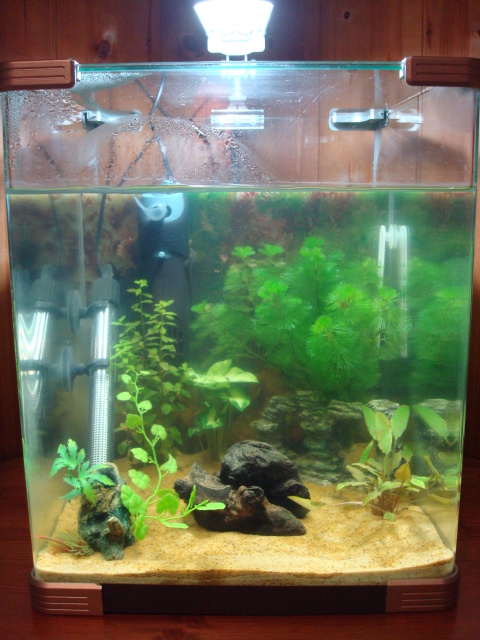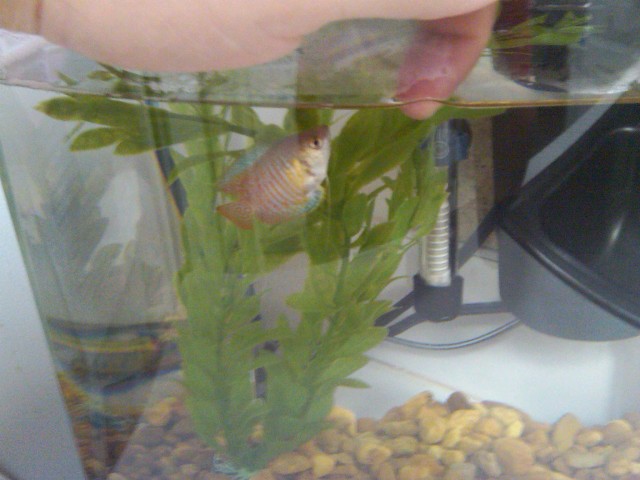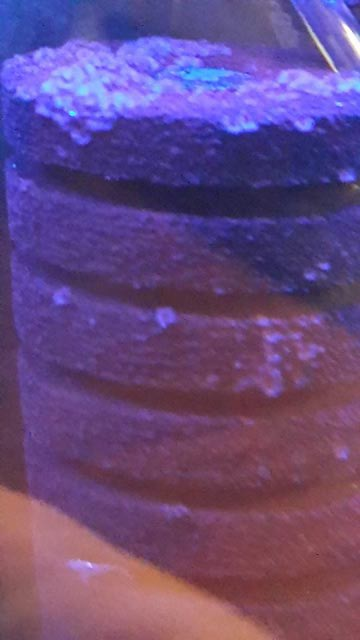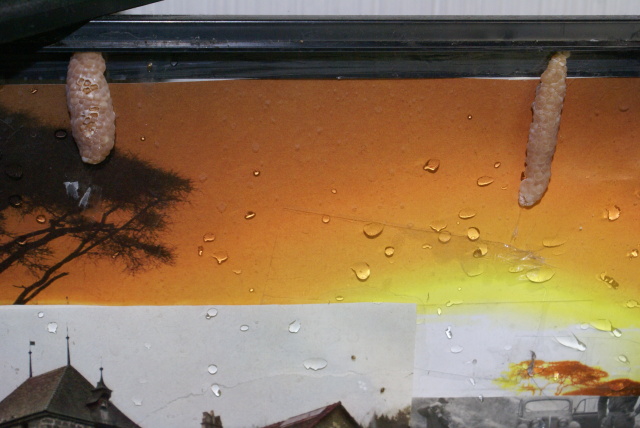QuestionQUESTION: Hi Karen, I saw you answered a question similar to mine on November 5, 2006. I have a Cory catfish that the other day I noticed had some discoloration near the front of its head, near its eye. It looks like an injury. However, nearby, further up on its head, there is a white spot that is protruding. It looks fuzzy, like it might be a fungus that is growing on part of where he was injured. I have also noticed that he seems to be trying to hide in our plants from the other fish. First of all, what might have caused his injury? We do have a small pleco that can be somewhat territorial, especially when we feed the bottomfeeders...could he be the cause? Secondly, how can we treat this fungus on our Cory? Thirdly, is this fungus contagious to the other fish? We noticed last week that it looked like some of the guppies had the 'shimmies', but we separated them, treated them, and they seem fine now (one just had 25 babies last night!). We also seem to be getting a lot of short little green algae growing...about a half centimeter long hairlike filiments...any tips to be getting rid of that? We have a 100 L tank and change 20 liters every Sunday. Is that enough to be doing for water changes or should we be changing more at a time?
Thanks so much for your help! I really appreciate it!
-Linda
ANSWER: Dear Linda,
If you do in fact believe it is fungus (and it sure sounds like it is from your description) you'll need to treat the little cory. Ideally in a special 10 gallon (about 37litres) with a good working power filter or sponge filter. And treated with a fungus medication that is -safe-for catfish, you have to make sure of that before beginning treatment. If you can't setup a hospital tank, unfortunately you'll have to treat the whole aquarium. First and most important, do a 75% water change and vacuum the gravel well. Fungus tends to thrive where there is much pollution in a tank and a cleaner tank to start with treatment is much more effective.
Use one of the many commonly available fungus treatments. You can go the natural route and use Pimafix and Melafix combination which are all-natural anti-bacterial/anti-fungal that are safe for catfish. Sometimes some fungus strains can be resistant or simply persistant, I've had good luck with Jungle Brand Fungus Clear which comes in tablets. When pimafix and melafix didn't work I used the Jungle brand fungus tablets and the fungus was gone in a few days. I also always do massive daily water changes during any treatment to further help the fish.
We can't be sure what causes the injury to happen, maybe the cory scraped himself on some rocks or on decor, or maybe another fish picked at him. The cory's symptoms and the guppies' shimmying may be signs that your tank conditions are not optimal. You are doing good by changing your water every week. But you may have to increase it to twice a week which is much, much better. Water changes all depend upon your stocking level and bioload (waste produced by the fish you keep) and your feeding routine. There is no golden rule for how much to change or how often, you have to go off your individual aquarium and it's stocking level. Plecos in general, although yours may be small, produce a high bioload in general and if there are lots of other fish in this tank the bioload may be very high. Stepping up the water changes to every day will be beneficial to all the fish at least for now until you can get the fungus under control.
The green algae is commonly called hair algae, it doesn't cause any harm really but may be a sign that your tank is getting too much light or there are too many nutrients available for the algae to thrive on (perhaps from a big bioload?) the best remedy for most all algae problems is to yes-- increase your water changes much more frequently, even if you have to do them everyday which really should be done when you have sick fish, and make sure to not have your lights on anymore than 10-12 hours per day. In fact, if the room the aquarium is in itself is well-lit from sunlight or room lights, you can turn your aquarium off some during the daytime to cut back on the light available to the algae. The fish won't mind, as long as they aren't being plunged into total darkness. Also, removing it by hand is very effective in control. Usually this algae is easy to remove by hand or may be scrubbed with an aquarium algae scrubber. Use your siphon when doing a water change to vacuum up the bits of algae you remove. With careful feedings and inreased water changes as well as a little light reduction, most algae problems can be kept at bay but remember a little algae is normal for aquariums and doesn't signal anything bad, unless it gets out of control, that's when there must be something not right with the conditions or something is unbalanced with the tank's nutrient load or lighting level.
I really hope this helps!
I wish you the best with treating your cory and guppies (congratulations on the 25 new babies!!)
Karen~
---------- FOLLOW-UP ----------
QUESTION: Hi Karen,
Thanks so much for your response. From what you have said and what I have read on the Internet, it seems daily water changes seem to be the answer. However, if we change so much water at once (75%!!) and start doing changes everyday, doesn't that mess up the bacteria in the filter and screw up the whole system? When we first set up the tank, we ran the filter for a month with no fish in the tank to establish the bacteria colonies...it seems like changing so much at once would disrupt the filter. Thanks again for your help! We are trying to vaccuum the gravel very well every time we change the water to try to get rid of any fungus...but we don't want to uproot the plants. Could it be under the gravel in the substrate where the plants are rooted?
ANSWER: Hi Linda, You're welcome as always!
Water changes are the simple key to preventing many fish illnesses as well as a great side-treatment for them.
The water changes will not disturb your bacteria. The bacteria are colonized on your gravel bed and in the filter. So removing even up to 90% in a water change won't do the bacteria harm. You can vacuum the gravel quite thoroughly with no trouble either. You just don't want to rinse your filter media in anything other than a bucket of tankwater and you never want to completely dismantle your tank and scrub everything. Most major fish breeders of Discus or Angelfish for example, change up to 90% in their spawning tanks everyday and sometimes even twice a day!
Not disturbing the plant roots is a tricky thing when you really need to gravel vacuum. Is it possible you could carefully siphon around your plants without chopping plant roots? Or at least gently disturb the gravel around the plants with your fingers and siphon the disturbed debri. This is tricky since plants don't like to be disturbed but you still must do it for your cory's sake. This is also why a hospital tank is very handy!
Just try to vacuum as much as you possibly can to siphon debri from the gravel and do pay special attention to corners or rarely disturbed areas. This should be done periodically anyway even when you don't have sick fish as a precaution against Anerobic conditions developing. This means that if the gravel becomes severely clogged in undisturbed areas such as around plants, underneath decorations or in the corners, the gravel becomes so clogged with debri that no oxygen reaches down into it anymore and what's called Anerobic bacteria begin to thrive. These are 'Bad' bacteria that can turn your gravel black and cause the tank to smell like rotten eggs (and I'm not joking about that!) the gases the bad bacteria release can be toxic to your fish so you want to prevent that as much as possible and that is simple with just thorough gravel vacuumings and regularly gently disturbing areas around plants to loosen debri and let oxygenated water get down into it.
Note that your Beneficial 'good' bacteria are Aerobic which of course means they thrive on oxygen.
I really hope this helps! And feel free to write with anymore concerns...
Best of luck!
Karen~
---------- FOLLOW-UP ----------
QUESTION: Okay Karen, you are now my go-to expert. I hope you don't mind! A few more questions...when I vaccuum the gravel, underneath is the 'soil' layer where the plants have their roots. Should I try to vaccuum and disturb all the gravel to make sure it is getting cleaned, or just vaccuum more at the top layer, disturbing the 'gravel' and not the soil? I don't want those nasty bacteria growing underneath though if I just do near the top, but also if it all gets mixed up, is it bad for the fish or plants?
Second, I also have a beta that looks like he is exploding. I have looked at many websites about his problem, but it seems like he either is constipated or has dropsy (even though his scales aren't sticking out). He has a HUGE bulge where I am guessing his stomach is...like a tumor or he is really bloated and swollen. He is acting normal though and wants to eat. For the past three days I have had him separated from the other fish and I haven't fed him except for a pea twice because I read online that it might help him poop to put it bluntly. There is white stuff coming out of him. It almost looks like little white eggs, but since he is a male fish, obviously they aren't. I also am not sure if it is 'poop' or an opening that has developed in him due to the swelling. He really looks gross but he is our favorite fish. Is there anything that would help him get rid of whatever it is inside of him causing the blockage?
Thanks for your help...as an update, unfortunately the little cory is no longer with us, but we have been changing a large percentage of water every other day and already the tank looks better. We do it every other day to have the water age a bit before adding it (so the chlorine, etc. goes away).
Thanks again for your help!
AnswerHi Linda (No problem, I don't mind at all!)
I'm sorry to hear you lost your cory. That is quite a shock, but these things happen sometimes.
With a planted aquarium, it is recommended that you vacuum only the top layer of gravel and the plants' roots will keep the lower levels of the substrate oxygenated. So you are probably fine there. Just make sure everyone is healthy including the plants as well as the fish. And test your water if you can. Your ammonia and nitrites should also be ZERO and nitrate should be 20 or less.
If the two different substrates (gravel/sand) get mixed up it might not be a big deal but some planted tank substrates will cloud the water pretty badly.
An exploding betta? Wow you've been having bad luck with your fish lately (I know how you feel!) On the more serious side, constipation is a very common problem with bettas although it can be hard to distinquish between constipation and other possible causes such as tumors, internal swelling due to kidney failure, dropsy, or even a cyst. Diagnosing bloated fish is extremely difficult from my experience. The fish that I've had in the past who have developed a swollen body as well as the other fishkeepers who has written to me about their swollen bettas and other fish.
So it's been three days right and you've tried the pea? I feel constipation should have cleared up by now. The white stuff is suspicious. When fish have white/clear and stringy like poop (put bluntly) it usually indicates internal parasites, but I don't think this is what your fish has since most fish who are affected with internal parasites become very, very thin and sickly. The only reason I can think of as to why his poop is that color is his change of diet to the peas. Or maybe he is constipated and he is having a difficult time clearing himself out so to speak. (Don't mean to get too graphic)
The pea feedings should certainly help.
Your betta may just need more time. Insure he has clean water always with plenty of frequent water changes and a warm temperature of at least 76-78 and ideally 80F to help his immune system, should he in fact be sick.
Dropsy is a terrible disease that is quick to destroy the poor fish infected by it. Usually the fish will hide back in the tank with very few obvious symptoms of being sick. Then one day he will be bloated and not too long after that his scales will stick out. The fish may or may not eat but will generally act sick, behaving very listless and staying in a far corner. Unfortunately there is few if any reliable treatments for dropsy.
Then, your fish could in fact have a tumor. This seems to happen a older bettas and as you know, unfortunately there is nothing you can do.
Internal swelling in bettas or any fish for that matter is so hard to diagnose that the owner of that fish is best of experimenting with their fish to try everything they possibly can to cure him. You could try the pea as well as Epsom salt which can help fish pass blockages. Use at a rate of 1/8 teaspoon per 5 gallons. For a small container like a 1gal bowl, you divide the 1/8 teaspoon into 5 equal parts and use one part per gallon. You could even try to get a grain of epsom salt into a particle of pea and then feeding that to your betta.
If this doesn't work after about 2-3 days you can try using a medication for internal infections such as Maracyn and/or Maracyn II both these medications can be used together and are usually quite effective in covering both gram-positive and gram-negative bacteria. Since your betta may be in a small container like a bowl, here is the dosages for Maracyn and Maracyn II- For Credit This is from HealthyBetta.com
_Maracyn_
1 Gallon Dosage:
Do 100% water change. Dissolve 1 tablet in 10 teaspoons of water. Add 1 teaspoon of concentrate per gallon. Add 1 teaspoon daily of the concentrate mixture.
_Maracyn II_
1 Gallon Dosage:
For one round, dissolve one tablet into 10 teaspoons of water. For first day, add 2 teaspoons of concentrated mixture per 1 gallon of water. For days 2-5, add 1 teaspoon of the concentrate per 1 gallon of water.
I can't guarantee any of these treatments for your betta will work. All you can do is try your best. That's all anybody can do when faced with a mystery fish illness, and certainly it's well worth it to try everything for the little betta.
I really hope this helps!
Best wishes and Happy fishkeeping!!
Karen~

 High Nitrite Level
QuestionQUESTION: Hi Renee
Approximately 3 weeks ago I
High Nitrite Level
QuestionQUESTION: Hi Renee
Approximately 3 weeks ago I
 another question, and thanks for your help
QuestionQUESTION: Hi, Renee. I wanted to thank yo
another question, and thanks for your help
QuestionQUESTION: Hi, Renee. I wanted to thank yo
 Pink fungus?
Question
pink fungus pink fungus
Hello,
I
Pink fungus?
Question
pink fungus pink fungus
Hello,
I
 wierd egg sack in newt tank
Question
eggs
I have a firebelly newt tank, with apple
wierd egg sack in newt tank
Question
eggs
I have a firebelly newt tank, with apple
 Yellow Platy with Spots
Question
Yellow Platy with spot
Large white spot
Yellow Platy with Spots
Question
Yellow Platy with spot
Large white spot